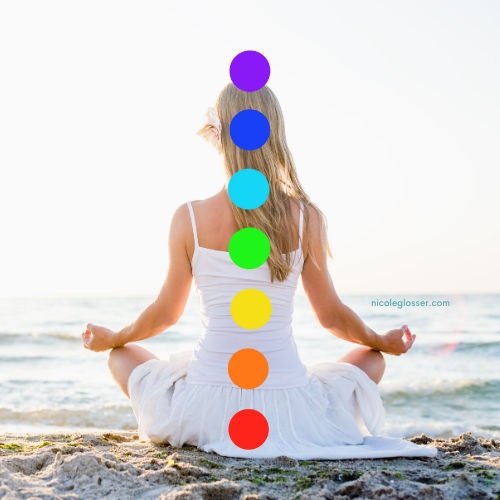Your cart is currently empty!
Chakras 101: A Beginner’s Guide

Ingrained in ancient wisdom, chakras are believed to be the centers of energy that regulate our physical, emotional, and spiritual well-being. The origins of the chakra system can be traced back to ancient India, where it was first mentioned in the Vedas, the sacred texts of Hinduism, around 1500 BCE. The word “chakra” comes from Sanskrit, meaning “wheel” or “disc,” representing the spinning vortex of energy within each center. There are seven main chakras that run along the central nervous system, from the base of the spine to the crown of the head. They are the Root Chakra, Sacral Chakra, Solar Plexus Chakra, Heart Chakra, Throat Chakra, Third Eye Chakra and the Crown Chakra.
Chakras are believed to oversee the energy pathways, or meridians, within our bodies. Meridians are the channels that energy uses to move through our bodies. It is understood that chakras are most likely located where meridians intersect with each other. Therefore, chakras are considered an essential part of maintaining harmony and balance within the body and mind.
Overview of the Chakra System:
- Root Chakra (Muladhara):
Located at the base of the spine, the Root Chakra (also known as Base Chakra) grounds us to the physical world, fostering feelings of safety and security. It is associated with the color red, symbolizing vitality and strength. - Sacral Chakra (Svadhisthana):
The Sacral Chakra is found in the lower abdomen and governs our creativity, passion, and emotions. Its warm orange hue embodies enthusiasm and joyous expression. - Solar Plexus Chakra (Manipura):
Set in the upper abdomen, the Solar Plexus Chakra empowers our self-confidence and personal power. Represented by vibrant yellow, it signifies liveliness and intellect. - Heart Chakra (Anahata):
The Heart Chakra is nestled in the center of the chest and embraces unconditional love, compassion, and emotional balance. Radiating in green, it embodies harmony and healing. - Throat Chakra (Vishuddha):
Located in the throat area, the Throat Chakra facilitates clear communication and authentic self-expression. Its calming blue color signifies openness and truth. - Third Eye Chakra (Ajna):
Positioned between the eyebrows, the Third Eye Chakra (also known as Brow Chakra) heightens our intuition and spiritual awareness. Its deep indigo shade symbolizes insight and inner wisdom. - Crown Chakra (Sahasrara):
At the top of the head, the Crown Chakra connects us to higher consciousness and divine wisdom. Beaming with violet or white, it represents spiritual enlightenment.
When the flow of energy in one or more chakras is blocked or disrupted, it can lead to physical ailments, emotional turbulence, and a sense of disconnection from ourselves and the world around us.
To promote well-being, various practices can be performed, such as meditation, yoga, breathwork, and energy healing. These methods help align and harmonize the chakras, promoting a sense of balance and vibrancy.
The chakra system offers a profound understanding of the intertwined connection between our physical and spiritual selves. By exploring and gaining an understanding of these ancient energy centers, we equip ourselves with the knowledge that can help us move toward self-awareness, healing, and spiritual growth. Remember, the chakra system serves as a guiding light, illuminating the path to harmony and enlightenment within ourselves and the universe.
